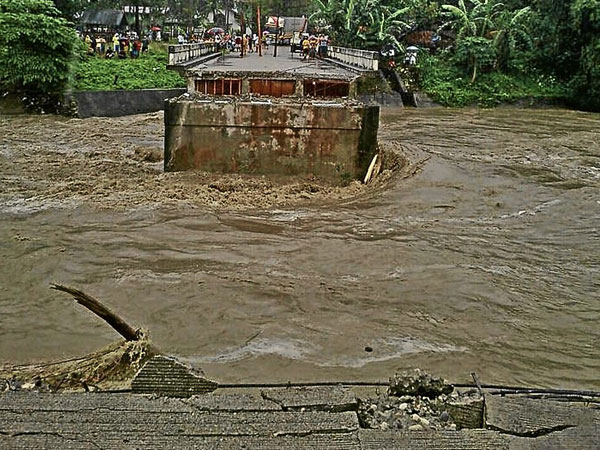Bridge collapse isolates devastated town

RAMPAGING floodwater with logs and uprooted trees destroyed the Caraga Bridge in Caraga town, Davao Oriental province, on Sunday morning. The town is now isolated from its neighboring town of Manay in the south and Baganga town in the east. Pyk Sibbaluca / CONTRIBUTOR
DAVAO CITY—Another bridge has collapsed in Davao Oriental, making Caraga town isolated.
The Caraga Bridge, which connects Caraga town to Manay town, was destroyed around 10:30 a.m. Sunday “by the rampaging water which carried with it uprooted trees,” Mayor William Dumaan told the Inquirer by phone.
The trees could be among those uprooted when Typhoon “Pablo” hit the east coast towns of the province on Dec. 4, he said.
But some residents said although some of the trees still have roots, there were at least “three big cut logs.”
Asked where the logs were, the residents said they were carried away to the sea.
Vice Gov. Jose Mayo Almario earlier warned that “the worst is yet to come” with the onset of the rainy season. He said that with no more trees to hold the rainwater, there would be flooding, with rampaging water carrying fallen trees with it.
At the height of Pablo, the Baogo Bridge, which connects Caraga to Baganga town, was destroyed by floodwater that had uprooted trees and logs.
The destruction of the Caraga Bridge has rendered the town totally isolated.
Another bridge in Cateel town is also facing collapse. Only light vehicles are allowed to pass the Papad Bridge, which connects Cateel and Baganga. If the bridge is destroyed, it will mean total isolation of the typhoon-ravaged town of Baganga, which can be reached through Cateel from the east and Caraga from the south.
Search ends
In General Santos City, tears flowed as wreaths were laid and white balloons were released on Saturday, signifying the end of the 45-day search and rescue operation for the 352 fishermen who went missing at the height of Pablo last month.
Lt. Gen. Jorge V. Segovia, commander of the Eastern Mindanao Command, came here on Wednesday and told the families of missing fishermen that “efforts of the government would be shifted from search and rescue to rehabilitation.”
The fishermen aboard 47 fishing vessels from this city and nearby Sarangani province disappeared when Pablo battered Eastern Mindanao on Dec. 4.
On Dec. 9, massive sea and aerial search and rescue efforts were launched. Using 22 boats, the Philippine Navy, Coast Guard, US Navy, Bureau of Fisheries and Aquatic Resources (BFAR) and different fishing companies scoured the fishing grounds covering some 500,000 hectares near Palau all the way down to Indonesia.
Navy Capt. Lued Lincuna told the Inquirer that 44 survivors were from General Santos City, Sarangani, Davao del Sur and Surigao del Sur. Fifteen bodies were retrieved.
Lincuna said the last time the team recovered a cadaver was on Dec. 12, “so, the task force decided to refocus its efforts to helping the families of the victims.”
On Saturday morning, the city government, the fishing federation, BFAR, Philippine Navy, Coast Guard and families of the missing fishermen held a fluvial wreath-laying ceremony on Sarangani Bay.
It was a symbolic mass burial to pay tribute to fishermen who perished at sea together with their fishing vessels.
Despite the holding of symbolic mass burial, Ramona Lacanilao, 42, a resident of Calumpang here, refused to give up hope. “I still believe my husband is alive. I will continue waiting for him,” Ramona said in Bisaya. Nico Alconaba and Aquiles Z. Zonio, Inquirer Mindanao
Subscribe to INQUIRER PLUS to get access to The Philippine Daily Inquirer & other 70+ titles, share up to 5 gadgets, listen to the news, download as early as 4am & share articles on social media. Call 896 6000.